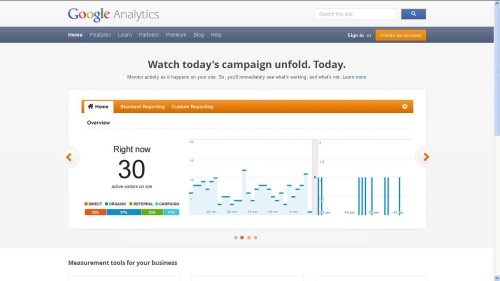Las herramientas con las que todo Community Manager tiene que estar armado
Toda empresa que desea alcanzar el éxito debe contar con un departamento (o persona encargada) de mercadotecnia. En el mundo actual de la Web 2.0 esos equipos de mercadotecnia destinan gran parte de sus actividades a los medios sociales. Parece un trabajo muy fácil y divertido (bueno, la verdad sí es muy divertido) pero no siempre es fácil.
Los medios sociales son una herramienta muy importante que nos ayuda a estar en contacto con nuestros clientes y atraer a nuevos, pero para que eso suceda, se debe llevar a cabo una importante labor de investigación y análisis del mercado. No basta con hacer muchas publicaciones o escribir artículos de blog diariamente, debe generarse contenido de calidad para los usuarios.
(Imagen: FLYCKR)
Una vez que se ha publicado el contenido en los medios sociales, sea alguna red social como Facebook o el mismo blog, se debe monitorear el alcance o número de personas a las que llego la información y de qué manera fue. Para ello hay distintas herramientas que se utilizan, cada una de ellas con un propósito diferente.
1. Google Analytics: Es la mejor herramienta para conocer el tráfico de tus páginas ya que te dice quien visita tu página, cuando, como, donde y principalmente el por qué medio ocurrió la visita, dividido en tres opciones: search, referral o directa.
Es muy importante saber de dónde llegan las visitas que tiene tu página ya que te permite conocer si tus seguidores son ‘propiedad tuya’, dando a entender que son clientes fieles que han estado siguiendo tu página desde el principio o si son seguidores ganados que visitaron tu página porque un tercero la publicó en algún medio social.
En esa misma pestaña del tráfico de visitas, viene una sección llamada referrals la cual se dedica especialmente a los medios de comunicación más utilizados en la actualidad, las redes sociales. Google Analytics te presenta todas tus redes sociales en orden y te dice cuánto tiempo duró la visita, que páginas se visitaron y así sabes cuál es la red social, que más visitas te gana.
(Imagen: Google Analytics)
Otra herramienta dentro de Google Analytics de mucha ayuda para nuestro equipo de medios sociales, son las famosas palabras clave o keywords. Como lo dice su nombre, son las palabras clave que emplean los clientes para buscar información. Si se usan adecuadamente, ayudarán a los usuarios a encontrar las páginas de tu empresa. Las palabras clave sugeridas deben verse como una retroalimentación y al mismo tiempo una sugerencia de qué palabras utilizar en los títulos de tus artículos, blogs, fotos, etc.
2. En el caso de Facebook, tenemos los famosos likes.Gracias a ellos, tienes conocimiento de cuántas personas están siguiendo a tu negocio y en cierta manera medir la participación de tu marca en el mercado. ATENCIÓN: Sólodebes buscar likes auténticos y bajo ninguna circunstancia deben ser comprados, pues ello te ocasionaría más daño que beneficio, como lo hemos explicado aquí.
3. Twitter tiene los re-tweets, que te ayudan a ‘medir’ la calidad de la información publicada, ya que si tienes muchos re-tweets quiere decir que ofreces contenido interesante y tus seguidores desean saber más al respecto(ocurre lo mismo en Pinterest, por ejemplo, cuando alguien hacer re-pin a algún pin publicado desde tu plataforma).
4. En Youtube tenemos las vistas, indicando cuánta gente ha visto tu video. Asimismo, la herramienta de drop offindica si los visitantes dejaron de ver tu video antes de que terminara.
(Imagen: FLYCKR)
Estar a cargo de los medios sociales en una empresa, puede parecer trabajo fácil, ¿quién no nos ha acusado de vivírnosla en Facebook?Ese tipo de comentarios podremos seguirlos escuchando de familiares y amigos, pero es peligroso que un community manager llegue a creérselo. Los medios sociales no son pan comido.
Fuentes: lunametrics | biznology
Any company that wants to succeed must have a department (or a person in charge of) marketing. In today’s world of Web 2.0 those marketing teams spend much of their time in social media activities. It seems a very easy and fun job (well, actually it is very funny) but is not always easy.
Social media is an important tool that helps us stay in touch with our customers and attract new, but in order for that to happen, you must carry out a major research and market analysis. It’s not enough to make many publications, write articles or blog daily, you should generate quality content for the users.
(Imagen: FLYCKR)
Once the content is posted in any social media, like Facebook or a blog, you should monitor the extent or number of people who got the information and how they got it. To do this you have different tools that are used, each with a different purpose.
1. Google Analytics: It is the best tool to know the traffic of your pages because it tells you who is visiting your site, when, how, where and by what means mainly the visit occurred, divided into three options: search, referral or direct.
It is very important to know where do visitors come from, because you can find out if your followers are ‘owned», implying that they are loyal customers who have been following your site from scratch or if they are ‘visiting supporters’ won because a third party published your information in a social environment.
On that same tab named visitor traffic comes a section called referrals which is dedicated especially to the most used media today, social networking. Google Analytics shows you all your social networks in order and tells you how long the visit was, which pages were visited and you will know which of your social network is the most visited.
(Imagen: Google Analytics)
Another tool within Google Analytics which is of great help to our team of social media, are the famous words or keywords. As the name implies, are the keywords that customers use to search for information. If used properly, they will help users find your business pages. The suggested keywords should be viewed as a feedback and also a suggestion of what words to use in the titles of your articles, blogs, photos, etc..
2. In the case of Facebook, we have the famous likes. Thanks to them, you know how many people are following your business and somehow measure the participation of your brand in the market. ATTENTION:You have to look if your likes are authentic and you should never, under no circumstances purchase them, as this will cause more harm than good, as we have explained here.
3. Twitter has the re-tweets, help you ‘measure’ the quality of published information, because if you have many re-tweets it means that the content offer is interesting to your followers ( in Pinterest for example, when someone do some re-pin pin released from your platform, it means they liked the content).
4. In Youtube you have the view, indicating how many people have viewed your video. Also, another tool is drop off , which indicates is they stopped watching your video before it had ended.
(Imagen: FLYCKR)
Being in charge of the social media in a company, it may seem like a easy job, people even accused us of just being on Facebook? We can keep hearing those kinds of comments from family and friends, but it is dangerous for a community manager to believe them. Social media is not a piece of cake .
Sources: lunametrics | biznology



